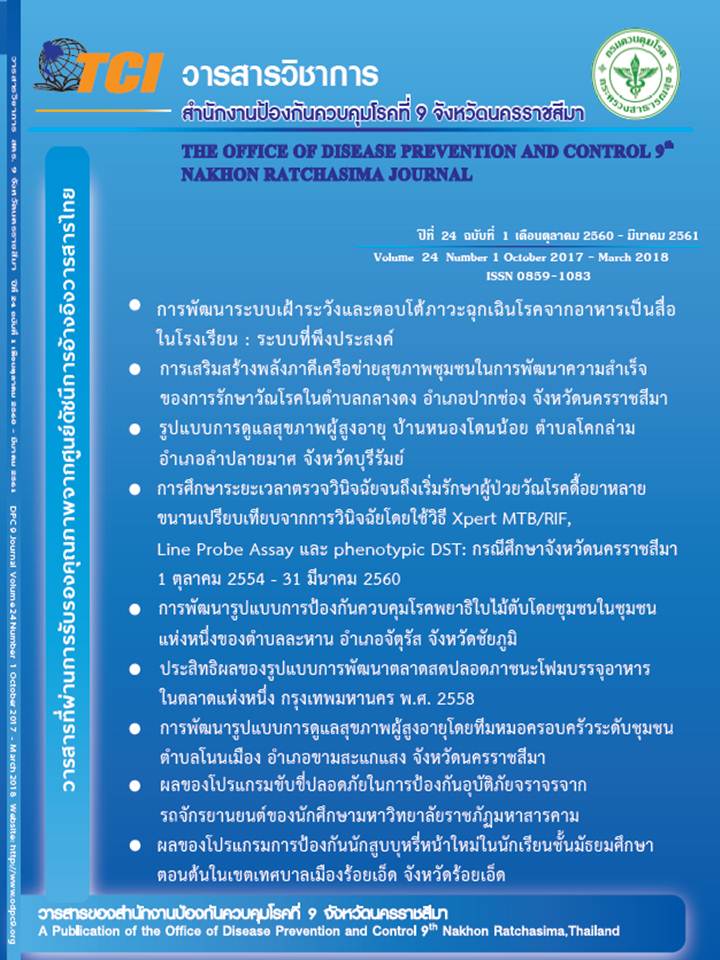Development of Surveillance and Response Systems for Foodborne Illness in School : Desirable Systems
Keywords:
surveillance, public health emergency, food borneAbstract
The objective of this research is to create the system of desirable surveillance and public health
emergency response in disease from food as a media in school with cooperative participants, in which the
corresponding in the program include school administrators, sanitary teachers, students, public health staffs,
and specialists in disease control. The research methodology undergoes through Participatory Action Research
using data collection from focus group discussion and assessment using qualify questionnaire. Then, analysis
the data in term of qualitative and descriptive achieve including mean and standard deviation. The result
shown that the system of desirable surveillance and public health emergency response in disease from food
as a media in school with cooperative participants compose of 5 main elements; 1) Management and follow up
the operation by appointment of the system of surveillance and public health emergency response in disease
from food as a media in school with cooperative participants committee. 2) Core working group members consist
of sanitary teachers and students were appointing for surveillance and public health emergency response
in disease from food. 3) Information system in gathering, analyzing, and reporting surveillance and public
health emergency response in disease from food. 4) Risk Communication 5) Disease control of risk factors,
proceeding and risk management to composition of desirable system shown high quality assessment.
References
from: www.ho.int/gho/epidemic_diseases/cholera/en.
2. กรมควบคุมโรค กระทรวงสาธารณสุข. แนวทางสำหรับครู เรื่อง การป้องกันควบคุมโรคอาหารเป็นพิษ
ในโรงเรียน. กรุงเทพมหานคร: โรงพิมพ์องค์การสงเคราะห์ทหารผ่านศึกในพระบรมราชูปถัมภ์, 2557.
3. สำนักสุขาภิบาลอาหารและนํ้า กรมอนามัย. รายงานสรุปข้อมูลสถานการณ์โรคติดต่อระบบทางเดินอาหาร
และนํ้าปี 2551-2555 กรณีโรคอุจารระร่วงเฉียบพลัน อาหารเป็นพิษ และอหิวาตกโรค. กรุงเทพ :
2556.
4. สุชาติ สุขเจริญ. รายงานการศึกษาปัจจัยที่เกี่ยวข้องกับสุขลักษณะของอาหารและนํ้าในศูนย์เด็กเล็ก. 2551.
เอกสารอัดสำเนา.
5. กรมอนามัย กระทรวงสาธารณสุข. คู่มือการประเมินโรงเรียนส่งเสริมสุขภาพ พ.ศ.2556. กรุงเทพมหานคร:
ศูนย์สื่อและสิ่งพิมพ์แก้วเจ้าจอม, 2556.
6. กรมควบคุมโรค กระทรวงสาธารณสุข. แนวทางสำหรับครู เรื่อง การป้องกันควบคุมโรคอาหารเป็นพิษ
ในโรงเรียน. กรุงเทพมหานคร : โรงพิมพ์องค์การสงเคราะห์ทหารผ่านศึกในพระบรมราชูปถัมภ์, 2557.
7. พัฒนโชค โชคสวัสดิ์ และคณะ. รายงานการสอบสวนโรคอาหารเป็นพิษในโรงเรียนเทศบาลตำบลแก้งคร้อ
อำเภอแก้งคร้อ จังหวัดชัยภูมิ. 2557. เอกสารอัดสำเนา.
8. บงกช เชี่ยวชาญยนต์. การพัฒนารูปแบบการเฝ้าระวังโรคติดต่อในศูนย์เด็กเล็ก จังหวัดตรัง. วารสารควบคุมโรค
2553 ; 36 (3) : 170-177.
9. สถาบันวิจัยระบบสาธารณสุข. ความรู้พื้นฐานด้านการเฝ้าระวัง สอบสวน ป้องกันควบคุมโรคสำหรับโรงพยาบาล
ส่งเสริมสุขภาพระดับตำบล. กรุงเทพมหานคร : สหมิตรพริ้นติ้งแอนด์พับลิสซิ่ง, 2555.
10. สมาคมนักระบาดวิทยาภาคสนาม. พื้นฐานระบาดวิทยา. กรุงเทพมหานคร: โรงพิมพ์แคนนากราฟฟิค, 2557.

Published
How to Cite
Issue
Section
License
บทความที่ลงพิมพ์ในวารสารวิชาการสำนักงานป้องกันควบคุมโรคที่ 9 จังหวัดนครราชสีมา ถือว่าเป็น
ลิขสิทธิ์ สำนักงานป้องกันควบคุมโรคที่ 9 จังหวัดนครราชสีมา



